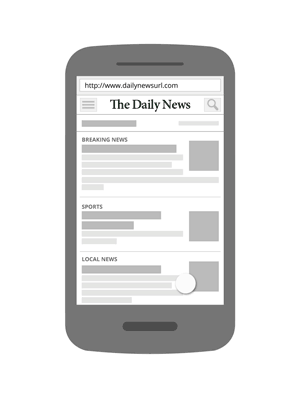We’ve all been there. You’re trying to send an article from your phone to a friend, or you’re playing a mobile game while waiting in line for a movie, when you accidentally touch an ad on your screen. You weren’t interested in the ad -- heck, you didn’t even have time to see what it was for -- but now you’re hitting the back button to get back to what you were doing. Not only do accidental clicks like these annoy users, but left unaddressed, they can drive down the value of ads.
Over the last four years, we’ve
introduced a
series of protections across mobile web and mobile apps to prevent accidental clicks like these on ads. Today we are continuing this commitment to protecting users and advertisers by extending accidental click protections to native ad formats.
Native ads were developed to help publishers and developers implement ads that complement the look and feel of their content.
Since our teams started instituting various click protections, we’ve learned quite a bit along the way. Here are two insights among many that guide our ongoing work.
Fast clicks are not real clicks
A professional baseball player has about 680ms
1 to react and swing at a baseball thrown at 90mph. That’s fast, even for a professional who’s paying close attention to hitting the ball. We think it’s virtually impossible for someone to read, understand, and take action on an ad in that amount of time.
 |
| Figure 1: A click is ignored when a user accidentally fast clicks on an interstitial ad |
Not surprisingly, we found super-fast clicks on ads to provide little to no value to advertisers. That’s why we ignore fast clicks that we detect to be accidental immediately upon ad load. Rather than our ads causing surprise low quality clicks, users can continue on uninterrupted.
Edge clicks lack value
If you’ve used a mobile device, you know fat-fingers are a reality of touchscreens: the average fingerpad is roughly 50px large when pressing down.2 When we’re swiping, pinching, and poking our screens, it’s easy to accidentally touch the edge of an ad that appears unexpectedly or is placed too close to tappable controls on your screen.
 |
| Figure 2: A click is ignored when a user misses adjacent content and accidentally hits the ad |
When we compared the performance of clicks from the edge of ads to those coming from the interior region, we found dramatically higher conversion rates and user intentionality on clicks toward the middle of ad units. A few years ago, we started to expand these protections across mobile placements resulting in ad clicks that are more intentional.
The overall benefits of click protections
Fast clicks and edge clicks are just two of the user interaction issues we prevent in order to deliver value to advertisers. By expanding protections like these to native ad formats on mobile, we observe conversion rates increase over 10% on average with minimal impact to long term publisher revenue. This combined with our previous efforts has greatly improved the experience with mobile ads for users and advertisers.
The protections we’ve put in place across mobile web and mobile apps prevent tens of millions of accidental clicks per day, saving users tens of thousands of hours. When we look at the effect for advertisers in mobile apps, we observe double the value per click. We work hard to ensure that the clicks advertisers are charged for are more meaningful, and we hope sharing insight on these protections helps raise awareness and guide the wider advertising ecosystem. Plus, we really love playing games on our phones too, and want to make sure that we’re only taken to an advertiser’s page when we mean to go there.
Posted by Alex Jacobson, Product Manager, Ad Traffic Quality
Footnotes:
1) 90ft/132 ft per second = 681ms, 132 ft per second = 90mph